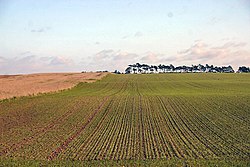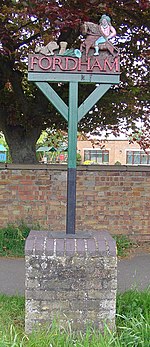Fordham, Cambridgeshire
| Fordham | |
| Cambridgeshire | |
|---|---|
 Fordham Moor | |
| Location | |
| Grid reference: | TL630708 |
| Location: | 52°19’12"N, 0°22’48"E |
| Data | |
| Population: | 2,712 (2011) |
| Post town: | Ely |
| Postcode: | CB7 |
| Dialling code: | 01638 |
| Local Government | |
| Council: | East Cambridgeshire |
Fordham is a village in rural Cambridgeshire, in the east of the county, four miles north of Newmarket. It is alone amongst its fields, closest to Exning (in the 'Newmarket Bubble' of Suffolk), and to the Cambridgeshire villages of Soham, Burwell and Isleham.
Church
The parish church has been dedicated to St Peter since around 1850, prior to which it had been dedicated to St Mary since at least the 14th century. The present building consists of a chancel with side chapels and a two-storeyed north chapel, an aisled and clerestoried nave with south porch and west tower. It is a grade 1 listed building.[1]
The earliest parts of the building date from the 12th century, and stonework suggest that by 1200 it was already its present size. The majority of the current structure date from an extensive rebuild in the 13th century. The church is noted for its fine 14th-century north chapel, unusual in having an upper floor and undercroft.
History
The parish has been occupied for several thousand years; weapons and tools in both flint and metal have been found from the Early Bronze Age and Iron Age, as well as pottery and burials. Wall plaster and tiles have been found from the Roman era, indicating that villas may have been sited near to Biggin and Block Farms in the 2nd to 4th centuries A.D.
In the Middle Ages the village was home to Fordham Priory, a Gilbertine priory and cell to Sempringham Abbey that was founded in the reign of King Henry III in the 13th century by Robert de Fordham.[2] Fordham Abbey, a Grade II* listed Georgian manor house was built on the site of the Priory in the eighteenth century.
Fordham had a railway station serving as a junction the Cambridge to Mildenhall railway and the Ipswich to Ely line that opened to the west of the village in 1879. The station finally closed in 1966.
Though spelled Fordeham in the Domesday Book of 1086, the village's spelling has remained unchanged since the 10th century. The name "Fordham" means just what it seems: 'ford homestead'.[3]
Village life
The village has a Church of England-controlled Primary School which feeds into Soham Village College.[4]
Fordham has two pubs. The Chequers and The Crown, which were both open by 1760. The Greyhound, which opened in the 1990s, converted into a restaurant called The White Pheasant. Other former pubs include the Green Dragon (previously known as The Bull) on the Market Street green, which was also open by 1760 and closed by the 1960s.
Fordham Community Archive has been set up to record the history of Fordham in the form of photographs, documents and written and oral memories. The group was formed in August 2007 and holds community events.[5]
Environment
Fordham Woods nature reserve is located south of the village.
Miscellany
A Ham class minesweeper HMS Fordham is named after the village.
The 'Hedgerow poet' James Withers lived in the village. Fordham is the birthplace of operatic bass-baritone Darren Jeffery.
Outside links
| ("Wikimedia Commons" has material about Fordham, Cambridgeshire) |
